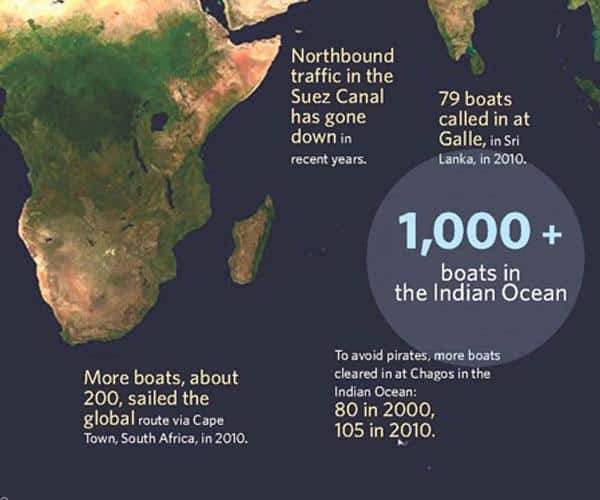There has indeed been a marked increase in local traffic in Southeast Asia, with more local boats, racing and cruising, joining the rallies and regattas held during the winter season in western Malaysia and Thailand. The figures from Phuket, Thailand, verify the increase in Asian visitors but reveal a net reduction in other foreign-flagged boats, as many of those on a world voyage now avoid the North Indian Ocean, due almost entirely to the threat posed by Somali pirates.

It’s estimated that between 250 and 300 yachts transit the Torres Strait, north of Australia’s Cape York Peninsula, every year. Heading west from there, most boats normally stop at Darwin, Australia. According to official records, 69 yachts cleared into Darwin in 2010, not including 70 foreign boats that joined the Sail Indonesia Rally in Darwin, which attracted a total of 106 boats, of which 36 were Australian.
Indonesia saw a record 615 visiting yachts, which is the number of cruising permits, or Cruising Application for Indonesian Territory, that were issued in 2010 by the Ministry of Foreign Affairs. Bali, Indonesia, is an important cruising hub and gateway into the Indian Ocean, and most west-bound boats stop there, regardless of whether they are planning to continue through Southeast Asia and the Red Sea or take the Cape of Good Hope route.
A total of 220 boats stopped at Bali Marina, of which approximately half continued into the southern Indian Ocean. The nearest stops along this route are the two Australian outposts, Christmas Island, which saw 27 arrivals, and the more popular Cocos Islands (Keeling Islands) with 69. From there, the route splits into a northern branch leading to the Chagos Archipelago, and a southern branch to Mauritius, east of Madagascar off the east coast of Africa. Mauritius recorded 174 arrivals, among which 49 boats were described as local traffic as most had sailed over from neighboring Réunion. On the northern route, Chagos was visited by 105 yachts.
The larger than usual number that called at Chagos, a British territory, was due to an influx of boats that were originally bound for the Red Sea but had changed their plans at short notice because of the increased threat of piracy. As a result, 2010 was the first year when more boats appeared to have taken the Cape of Good Hope, Africa, route than to have sailed across the northern Indian Ocean to the Red Sea and Suez Canal.
For those who prefer to sail the until-now more common route, Phuket, in Thailand, and Langkawi, in Malaysia, are the favorite places to prepare for the crossing of the northern Indian Ocean. Yacht Haven Marina in Phuket deals with most foreign visitors and the manager estimated in 2010 that the total of foreign-flagged boats was 250, while Langkawi attracted around 150 yachts.
As some of those boats called at both places, it’s assumed that approximately 300 to 350 long-distance cruising boats pass through Southeast Asia every year. About one half of those boats used to sail to the Mediterranean Sea in the past, but that figure is now closer to one quarter.
The most popular ports of call along the northern route are Galle, in Sri Lanka, where 79 boats called in 2010, while the Maldives were visited by 98 and Mumbai, in India, saw 36.
In recent years, many of the boats bound for the Red Sea called first in the Middle East at Salalah in Oman, to join convoys and sail from there in company through the critical area in the Gulf of Aden.
A good indication of movement in the Indian Ocean is the number of transits through the Suez Canal, where the northbound traffic has been going down in the last few years. Numbers also show that approximately 200 boats sailed the Cape of Good Hope route in 2010. This estimate is based on statistics obtained from two key sources: Cape Town, South Africa, and St. Helena. The various yachts clubs and marinas in the Cape Town area recorded a total of 121 visiting yachts during 2010. Because of St. Helena’s strategic location in the South Atlantic, few yachts bypass the island without stopping. The 169 yachts that called at St. Helena show an increase over the 137 arrivals in 2006.








